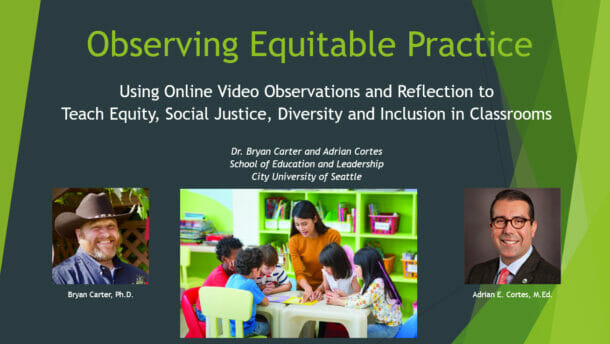12 Questions to Ask When Reflecting on Culturally Responsive Teaching
Culturally responsive teaching is key to equitable and inclusive education for all students. For candidates in higher education programs training to become teachers, learning to teach with a culturally responsive lens is not just about talk, it’s about action.
City University of Seattle’s undergraduate program director for teacher certification Dr. Bryan Carter put it this way:
“Equity right now is a big term in education. [But] we’re talking about it, not taking action. … What’s the tool on your belt when you step into the classroom with a variety of kids from a variety of backgrounds? What does equity actually look like?”
According to Dr. Bryan Carter and his colleague, associate teacher Dr. Adrian Cortes, classroom video is integral to answering both of those questions.
During the AACTE 74th Annual Meeting, the two City U teacher educators delivered the presentation, ‘Observing Equitable Practice: Reflections on Using Video Observations and Reflection to Teach Equity and Inclusion in Classrooms.’
Drs. Carter and Cortes discussed their recent research project focused on improving culturally responsive teaching using video to analyze teacher-student interaction in the classroom.
Watch the full video of their presentation above, discussing the use of online video tools, such as Edthena Video Coaching, for supporting teacher candidates in stronger culturally responsive teaching.
Or, continue reading for highlights and findings of their research, including 12 important questions for reflecting on classroom video to improve equity in teacher-student interactions.
Reflecting on video of classroom interactions supports more classroom equity

The goal of this research project, Dr. Carter said, was “to improve culturally responsive teaching by using video as a particular focus on our mannerisms, tone, and body language … the human interaction aspect.”
This differed from common topics that are analyzed and reflected on, such as lesson instruction or assessment.
Reflecting on the interactions between themselves and students, helped teacher candidates learn more tangibly about how they could improve their teaching to be more equitable.
Dr. Bryan Carter and Dr. Adrian Cortes’ research involved watching short video clips, recorded using Edthena, of teacher candidates engaging with students. Program candidates then reflected together and answered qualitative questions related to bias, assumptions, communication style, identity differences, listening skills, and classroom environment.
The reflection questions are:
- To what extent does race, gender, sexuality, ability, or class impact instructional delivery in the classroom?
- To what extent do you see bias and assumptions in the communication between the teacher and students? Consider verbal and non-verbal cues.
- How do students react to the teacher’s communication style and language?
- Is the teacher shifting focus and power away from the most privileged in the classroom conversations?
- Is the teacher making conversations accessible to everyone who wants to participate?
- Could the identity differences between the teacher and the student(s) be contributing to a difference of opinion or perspective?
- Is the teacher listening to people whose identities and experiences differ from their own?
- How might reflecting on the way the teacher communicates help improve the classroom environment, equity, and overall student success?
- Do all the students hear and react the same to what the teacher communicates, both verbally and nonverbally?
- How does the teacher adjust their communication to connect with each student, if at all?
- Is the teacher listening to the student(s)? What does the teacher’s “listening” look like?
- Is the teacher providing a safe place for people who have been historically marginalized people to speak out?
When reflecting on classroom video, teachers can consider one or more of these questions to think more deeply about their equitable teaching practices and how to improve further.
Inspired to improve culturally responsive teaching
What inspired this research project on using video to improve classroom equity? The presenters noted two sources of inspiration.
Dr. Carter spoke about the field of social work, where the training process (for example, in conducting therapy with children) is often filmed. Elements such as body language, voice/tone, word choice in the interactions are reflected upon.
“Why aren’t we doing this as teachers? We talk about our interactions, we talk about our assessments, we talk about what activities we are doing in the classroom; but how much do we spend talking about human interaction?” posed Dr. Carter.
Presenter Dr. Cortes also talked about the work of Zaretta Hammond, a leading expert and author on culturally responsive teaching.
Dr. Cortes said, “Zaretta Hammond described the ‘Ready for Rigor’ framework in which teachers really help facilitate student learning with the aid of neuroscience to deepen the understanding of what goes on in the classroom.”
Using work already happening in other fields, as well as the expertise and research done by Zaretta Hammond, the City U teacher educators were driven to explore how looking at classroom interactions could expand classroom equity.
Observing equitable practice in classrooms
The two higher-ed teacher educators highlighted the importance of body language, tone, and eye contact in teacher-student communication. Notably, they suggested that using video to analyze these interactions can help teachers develop a better understanding of these elements and how it impacts their students.
If you are thinking about how to improve your approach to culturally responsive teaching, consider how video can be the insightful look you need at your own teaching.
For more from Dr. Bryan Carter, check out highlights from his presentation at the AACTE 73rd Annual Meeting here: Increase Student Equity and Inclusion by Reflecting on Your Videos
For more from Zaretta Hammond on why using video is key to equity in teaching, check out this YouTube video: Classroom Video is the Most Powerful Tool in Service of Equity

